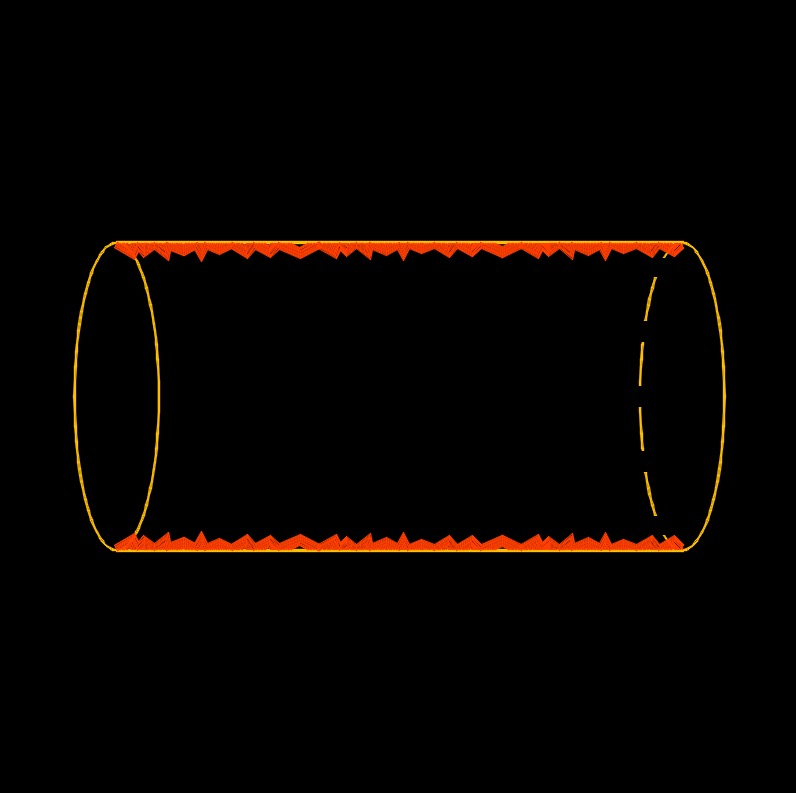Absolute Roughness
Absolute Roughness |
||
| Type of Pipe | Absolute Roughness in Feet | Absolute Roughness in Inches |
| Drawn Tubing (glass, brass, plastic) | 0.000005 | 0.00006 |
| Commercial Steel or Wrought Iron (new) | 0.00015 | 0.0018 |
| Commercial Steel or Wrought Iron (existing) | 0.0005 | 0.006 |
| Cast Iron (asphalt dipped) | 0.0004 | 0.0048 |
| Galvanized Iron | 0.0005 | 0.006 |
| Cast Iron (uncoated) | 0.00085 | 0.0102 |
| Wood Stave | 0.0006 to 0.0003 | 0.0072 to 0.0036 |
| Concrete | 0.001 to 0.01 | 0.012 to 0.12 |
| Riveted Steel | 0.003 to 0.03 | 0.036 to 0.36 |

Absolute roughness, abbreviated as \(\epsilon\) (Greek symbol epsilon), is the measure of the roughness or irregularities on the internal surface of a pipe or conduit relative to the size of the pipe. It is used in fluid dynamics and engineering, particularly in applications involving the flow of fluids through pipes, tubes, or channels. The absolute roughness of a pipe's interior surface plays a significant role in determining the frictional resistance to fluid flow within the pipe. The rougher the internal surface, the greater the frictional losses, and the more energy is required to pump or transport the fluid through the pipe. Conversely, smoother internal surfaces result in lower frictional losses and are more energy efficient.
Key Points about Absolute Roughness
Hydraulic Engineering - Absolute roughness is essential for designing water distribution systems, sewer networks, and irrigation systems.
Oil and Gas Pipelines - In the oil and gas industry, knowing the absolute roughness of pipelines is crucial for calculating pressure drop, optimizing pumping operations, and ensuring efficient transport of fluids.
Heat Exchangers - Absolute roughness is considered when designing heat exchanger tubes to determine the heat transfer coefficient and pressure drop.
Chemical Process Engineering - It is used in the design of chemical processing equipment and piping systems to optimize fluid flow and minimize energy consumption.
Absolute roughness is used in conjunction with the inside diameter to calculate the friction factor using a Moody Diagram, the Reynolds Number and the Darcy-Weisbach Equation.
Absolute Roughness Interpretation
The ratio of the absolute roughness (\(\epsilon\)) to the hydraulic diameter of the pipe (\(d_h\)) is often used to categorize fluid flows into different regimes.
Smooth Pipes (\(\large{\frac{\epsilon}{d_h}}\) < 0.001) - In this regime, the flow is considered to be in the hydraulically smooth region, where the effects of pipe roughness on flow are minimal.
Transition Flow (0.001 < \(\large{\frac{\epsilon}{d_h}}\) < 0.01) - In this range, the flow is in transition between laminar and turbulent, and the effects of pipe roughness become more significant.
Fully Turbulent Flow (\(\large{\frac{\epsilon}{d_h}}\) > 0.01) - In this regime, the flow is considered fully turbulent, and pipe roughness has a substantial impact on flow characteristics.
The absolute roughness value varies depending on the material of the pipe or conduit and the condition of its internal surface. Engineers often rely on published values or conduct experiments to determine the absolute roughness of specific materials under specific conditions. Common materials like steel, PVC, and concrete have well documented absolute roughness values that engineers can use in their calculations.

